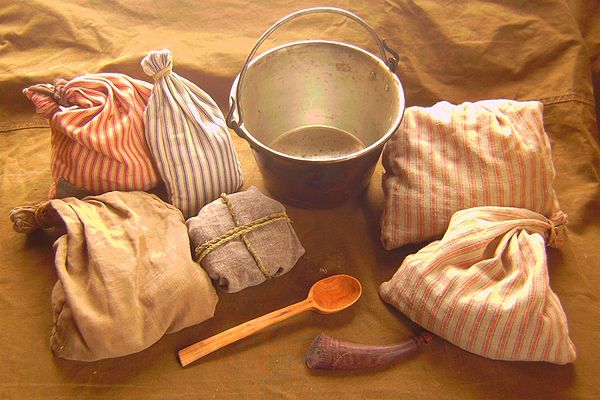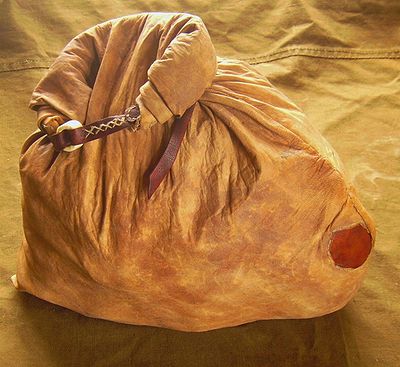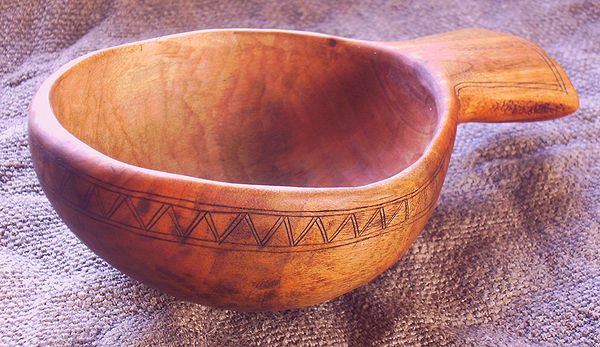Áistan: Food
FOOD/WATER/COOKING
Thankfully, Tolkien provides a thorough description of the kinds of rations available to travelers in the “green vale” of the Anduin. After the escape from Goblin-town, Bilbo forages sorrel and wild strawberries (the blackberries were only flowering at the time), and sees thyme, sage, and marjoram growing wild (TH 97). When Thorin and Company take leave of Beorn, he sends them off “…with food to last them for weeks with care, and packed so as to be as easy as possible to carry—nuts, flour, sealed jars of dried fruits, and red earthenware pots of honey, and twice-baked cakes...' (TH 132).
For nuts, I carry a bag of English walnuts and (when I can get them out of the hedge before the squirrels get to them!) filberts.
While I am accustomed (in my 18th century persona) to carrying a pound or two of coarse-ground parched gourdseed maize, (which I mix with warm water and a sweetener to make tasty sort of porridge), a bag of wheat flour by itself isn’t terribly appetizing; I like to think that Beorn intended the Company to use the flour to make ‘bannock’ or boiled dumplings. To approximate the agriculture of ancient Europe, I carry a pound or so of ground spelt (an older variety of wheat), mixed with bur oak flour and a bit of gluten protein to help it stick together. I also pack a bag of chestnut meal, which makes a tasty breakfast porridge when sweetened with honey.
While the “sealed jars” might bring to mind modern screw-top canning lids or snap-top ‘lightning stopper’ closures (patented in 1875), a traditional method of sealing vessels (for pickling &c.) was to use animal bladders. However, I have yet to find a ceramic jar that is not only light and strong, but also large enough to hold a trek’s worth of dried fruit. In lieu of a ceramic vessel, in a cloth drawstring bag I carry dried strawberries (which grew wild east of the Mistys^) and apple slices.
Thinking of the cram of Dale and Lake-town, as well as Beorn’s honey-cakes, I imagine that similar traveling rations are common to the various Northmen cultures. We are told that the making of Beorn’s honey-cakes “was one of his secrets”, and so I imagine this secret is kept by those ‘racial’ Beornings who claim direct descent from Beorn, who likely preserve his strict dietary practices as an identifier of their culture. The common Beorning cram I bake is a hardtack made of acorn and spelt flour. Between my belt pouch and food bag, I try to carry about twenty biscuits. These biscuits will keep you alive, and don’t taste that bad—the nutty acorn flour and lots of honey makes them quite tasty! After all, the Beornings are said by Gimli to be “the best bakers” (FotR 415).
recipe:
3 ¼ c wheat flour ¾ c acorn flour (Bur oak—Q. macrocarpa) 4 TB gluten powder—extra protein=more filling! 1 tsp sea salt 1 ¼ c whole milk (or very concentrated dry milk) 1 c honey
Combine ingredients, roll out 3/8” thick, cut into 3” circles; makes about 30. bake @ 325 ~35 minutes or until mostly hard.
In addition to the above foods, I carry a variety of dried (jerked) meats—venison, beef, or ham. While Beorn seems to be a vegetarian, I do not think that the common Beorning Men who united under him would be subject to this prohibition as well: I think only his skin-changing descendants maintain his unique dietary practices. Mostly, I can’t imagine having to get by without game in the backwoods! In winter, my preferred calorie-dense fuel is a kind of pemmican, which I make from lean venison, dried cranberries, cherries, and strawberries, sweetened with honey, and beef tallow as a binder. While traditionally thought of as a Native American foodway and not attested to in Tolkien, all ingredients would be known to an ancient European Beorning.
My dry goods I pack in bags made of red or blue pillow ticking. These are more appropriate for (and originated from) my 18th century kit, but for something as utilitarian as food bags, I let them slide. Perhaps they come from the looms of the more ‘modern’ Shire, or of Dale, post 2941? Good-quality material was found at JoAnn crafts in the ‘utility fabrics’ section ($7/yd?—which is enough for several decent-sized bags).
On a long trek, I like to carry a wheel of cheese in my rations. Cheese is eaten throughout Middle-earth, but is never specifically mentioned in Wilderland; however, Beorn lives on dairy and beekeeping: if (as I believe) his lifestyle is indicative of the regional culture, it is only logical that someone from the area would make cheese and dip the wheels in wax. On the trail, I wrap the cheese in a large piece of beeswaxed linen secured with nettle cordage.
Rounding out my consumables, I carry a small goat horn of coarse salt. While salt is known in Middle-earth (cf Samwise), I don’t know where it comes from: Ered Luin? Belfalas coast of Gondor? Harad?
All of my various drawstring bags and eating gear (minus my kettle) are carried in a large goatskin roll-top food-bag. Filled with jerky, hardtack, flour, fruit, nuts, cheese, salt, and a spoon, it weighs about seven pounds, which if carefully rationed can last five or six days.
I need to make some kind of container for Anduin seasoning herbs!—thyme, sage, marjoram.
At some point, I would like to carry some dried herbs (such as roasted dandelion root, wintergreen, white clover &c) in a horn or birchbark container for tea-brewing, …
- Proper tea is drunk in the Shire, and I suppose possibly traded east. Other possibilities are not documented specifically, but Beorn’s honey is clover-based. It is not unreasonable that a well-versed woodman would know what makes good tea.
Current eating gear:
- A tin-lined brass trade kettle: this holds about a half-gallon of water, but is somewhat unnecessary as none of the my food really requires cooking; though it is handy for heating water for tea, melting snow or ice, or for rehydrating dried vegetables I sometimes carry for stew.
- A hand-carved birch spoon
- I currently hang a small ‘noggin’ (holds about 2/3 cup) on my pack. I carved it from river birch (Betula nigra), decorated with an Old European ‘water’ motif. I tie it onto my pack with a thong of greased buckskin.
We know that Beorn served mead to Thorin’s dwarves in “wooden drinking-bowls” (TH 125, 126, 240). Because they are expressly stated to be drinking-bowls, I do not think we should picture the dwarves comically sipping from large soup bowls, but instead smaller bowls, perhaps like traditional Scandinavian ‘kuksa’ cups. Combined with this image and their more frontiersy culture, I picture the Woodmen and/or Beornings having a tradition of carved bowls, as opposed to the bowls of “turned box-wood” (TTT 318) which are documented in Gondor in the late Third Age. I do have a few simple turned bowls that I use for eating, but I imagine these having been brought north up the Anduin via trade with Gondor prior to about 3009 TA (FotR 438; RotK 410); as such they are more ‘luxury’ or ‘prestige’ items, and so stay safe at home.
WATER
For carrying water while out and about, my main canteen is a Second World War British surplus enameled metal canteen. These can often be found on ebay for less than $30 (including shipping!). The canteen’s design has definite historical pedigree: it is all but identical to a tin canteen from Fort Ligonier in Pennsylvania; the pattern can be seen in Sketchbook ’76 on page 47. It holds just over a liter, but unlike my gourd canteen, I don’t have to worry (too much) about this canteen freezing and rupturing, or being stepped on, or acquiring an ‘off’ taste. Additionally, I can put it directly in a campfire to heat water, which hypothetically could remove my need to carry a kettle. To help carry the canteen, I stitched together an outer cover of frontiersy leather and a liner made from an old wool sweater. In winter, the liner insulates and allows me to use it as a ‘hot water bottle’—I can boil water in my canteen before I go to bed, cover it in the wool, and keep my toes or hands toasty in my bed.
The whole assembly hangs under my right shoulder on a strap of buckskin and nettle fibers which I harvested, processed, spun, and wove on my inkle loom. Although my canteen is made of enameled iron and not tin (of which historical canteens were typically made), tin, iron, and glass (the source of enamel) were all known at the end of the Third Age, and so I am inclined to think my canteen is probably ‘of dwarvish make’ from post-2941 Erebor.
To go with all of my canteens, I also made up a cane container of water-purifying iodine tablets to go with the gourd (because our culture’s relentless pursuit of Saruman-ism has resulted in all water being unsafe to drink without processing)!


